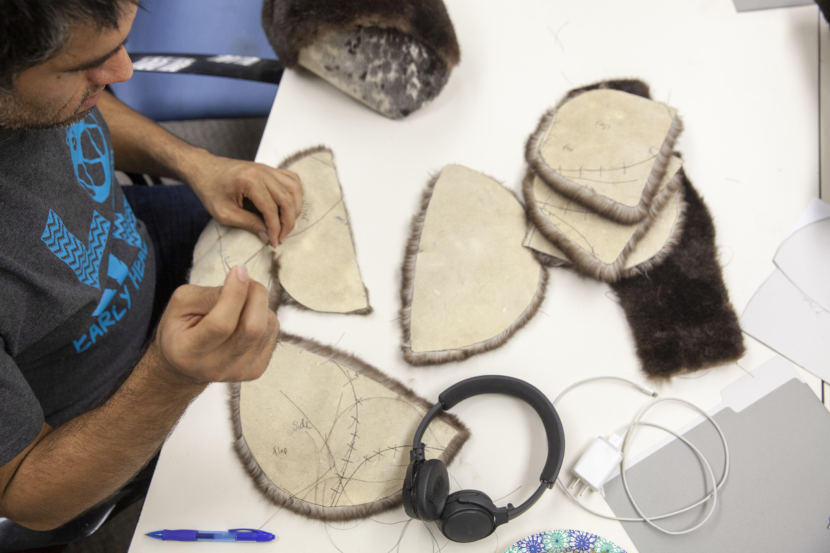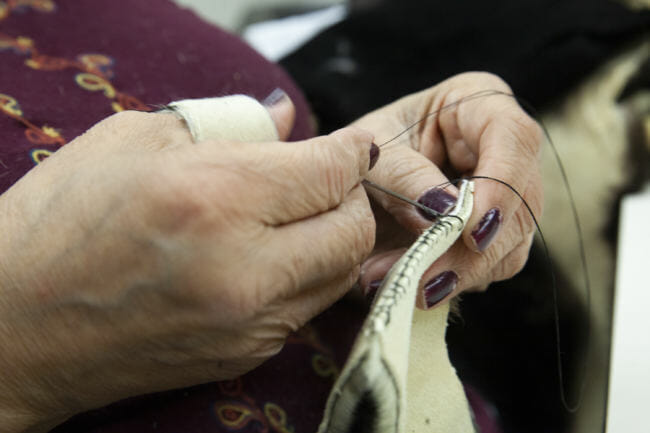
A series of workshops in communities around Southeast Alaska aims to expand the practice of traditional Alaska Native skin-sewing with seal and sea otter fur.
Sealaska Heritage Institute hopes the classes can promote cottage industries in smaller communities and maybe even offer a sustainable solution to the region’s fast-growing sea otter population.
Sea otter fur is soft — really soft. It’s the densest fur of any mammal on Earth, which is what makes it so warm and almost entirely waterproof.
That’s why they were wiped out by over-hunting in the region more than a century ago.
“Prior to 1960s, sea otters were gone from Southeast Alaska. There were none here,” said Lee Kadinger, Chief of Operations for Sealaska Heritage Institute. “So for two generations, people didn’t work with sea otter anymore, and so the knowledge of that was lost.”
In the last few decades, things have been looking up for sea otters in Southeast Alaska. The last official count put their number well over 25,000 and growing.
“It’s a very thriving population growing probably 10 to 12 percent a year,” Lee Kadinger said.
That may be good news for the otters, but it’s become a major concern for fishermen who compete with them for crab, clams and other seafood — fishermen like Gary Leask, a retired longshoreman from Ketchikan.
“The otters are starting to show up more around Ketchikan now, so we got to start getting rid of them. They kill all our crab, and I love crab,” Leask said. “There’s got to be a little bit of population control.”
Leask visited Juneau in October for a skin-sewing class to learn how to work with sea otter and seal pelts.
Under federal law, only Alaska Natives can hunt sea otters and work with their hides. They can sell what they make to non-Natives, but only if the product has been “significantly altered.”
When I met Leask, he was working on a trapper hat to wear when he’s out on his skiff in winter. A big guy with large hands, you could tell he was concentrating hard as he carefully sewed the lining of his cap.

He was also getting some help from Louise Kadinger, the instructor for the class and Lee Kadinger’s wife.
Growing up in Hoonah, Louise learned skin sewing from her grandmother.
“Now, like 40 years later, we don’t have people that know how to do this, and I know how and I am so willing to share with whoever wants to learn it,” Louise Kadinger said.
This is the first of 11 classes Sealaska is sponsoring in communities across Southeast and Anchorage over the next few months, taught by Louise and others. Participants have to be at least a quarter coastal Alaska Native to register.
They’re meant to be introductory, teaching everything from how to stretch and dry the hide to choosing a pattern and stitching the pieces together.

Leask had never sewed before the class, but he said he wants to take the follow-up machine sewing class when it’s offered next year. He’d like to continue working with skins.
“I wouldn’t mind start selling them, because I’ve got other people down in Ketchikan who want to hunt too,” he said.
Lee Kadinger said several students have started businesses over the years based on what they learned in one of these workshops. Some of them fish commercially in the summer and then work with furs in the offseason.
“And we really see it as an effort to spur and to grow village economies,” Lee Kadinger said. “These are wonderful little cottage businesses that can come together and survive in Hoonah or Angoon or Kake.”
It takes a lot of work and patience to get to the point where you can build a business.
Even at the beginner level, it’s harder than the youngest student in the class, 12-year-old Jaylynn Martin, expected.
But she says she doesn’t mind.
“I mean at this point, it was worth it,” Martin said. “Look at this thing — it’s soft!”
Registration is full for the next two skin-sewing classes in Hoonah and Ketchikan. Future classes are planned in Yakutat, Sitka, Saxman, Kake, Klawock and Anchorage.
